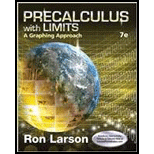
a.
To identify the parent function f for the given function.
a.
Answer to Problem 51E
Parent function is
Explanation of Solution
Given:
Calculation:
To identify the parent function of given function, first
Calculation for graph:
Consider
| Values of x | Values of f (x ) |
| 0 | -23 |
| 1 | -34 |
| -1 | -14 |
| 2 | -47 |
| -2 | -7 |
By taking different values of x , the graph can be plotted.
Graph:
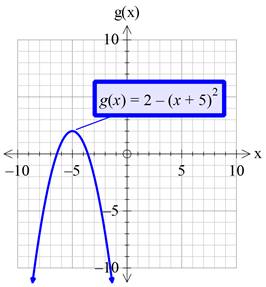
Interpretation:
From the above graph, it is clear that, the parent function is:
Conclusion:
Therefore, the parent function is:
b.
To determine the transformation from f to g.
b.
Explanation of Solution
Given:
Calculation for graph:
Consider
| Values of x | Values of g (x ) |
| 0 | -23 |
| 1 | -34 |
| -1 | -14 |
| 2 | -47 |
| -2 | -7 |
By taking different values of x , the graph can be plotted.
Graph:
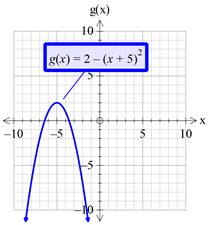
Calculation for graph:
Consider
| Values of x | Values of f (x ) |
| 0 | 0 |
| 1 | 1 |
| -1 | 1 |
| 2 | 2 |
| -2 | 2 |
By taking different values of x , the graph can be plotted.
Graph:
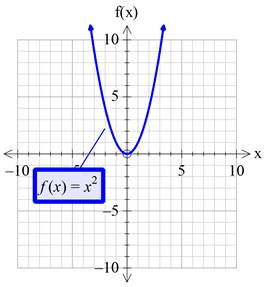
Now graph the functions
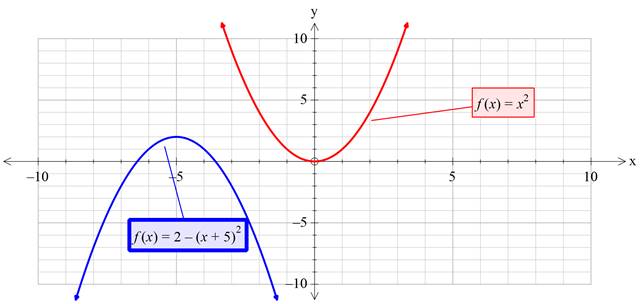
Interpretation:
Below are the steps to transform
Step 1: Take the reflection of
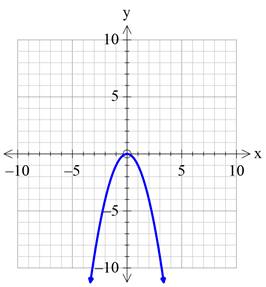
Step 2: Then shift the graph towards left by 5 units.
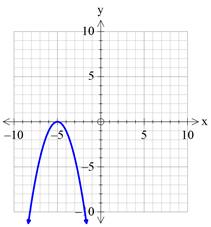
Step 3: Now shift the obtained graph by 2 units upward.
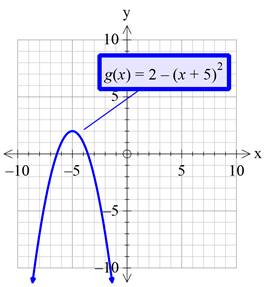
Conclusion:
So, by following the above steps, the graph of
c.
To sketch the graph of the function
c.
Explanation of Solution
Given:
Calculation for graph:
Consider
| Values of x | Values of g (x ) |
| 0 | -23 |
| 1 | -34 |
| -1 | -14 |
| 2 | -47 |
| -2 | -7 |
By taking different values of x , the graph can be drawn.
Graph:
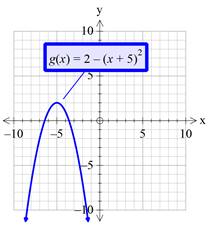
Interpretation:
The above graph represents the given function
d.
To write the function
d.
Answer to Problem 51E
Explanation of Solution
The parent function is:
Hence,
Given,
Putting the value of (i) in
Conclusion:
Hence, the value of
Chapter 1 Solutions
Precalculus with Limits: A Graphing Approach
- Ministry of Higher Education & Scientific Research Babylon University College of Engineering - Al musayab Automobile Department Subject :Engineering Analysis Time: 2 hour Date:27-11-2022 کورس اول تحليلات تعمیر ) 1st month exam / 1st semester (2022-2023)/11/27 Note: Answer all questions,all questions have same degree. Q1/: Find the following for three only. 1- 4s C-1 (+2-3)2 (219) 3.0 (6+1)) (+3+5) (82+28-3),2- ,3- 2-1 4- Q2/:Determine the Laplace transform of the function t sint. Q3/: Find the Laplace transform of 1, 0≤t<2, -2t+1, 2≤t<3, f(t) = 3t, t-1, 3≤t 5, t≥ 5 Q4: Find the Fourier series corresponding to the function 0 -5arrow_forwardMinistry of Higher Education & Scientific Research Babylon University College of Engineering - Al musayab Subject :Engineering Analysis Time: 80 min Date:11-12-2022 Automobile Department 2nd month exam / 1" semester (2022-2023) Note: Answer all questions,all questions have same degree. کورس اول شعر 3 Q1/: Use a Power series to solve the differential equation: y" - xy = 0 Q2/:Evaluate using Cauchy's residue theorem, sinnz²+cosz² dz, where C is z = 3 (z-1)(z-2) Q3/:Evaluate dz (z²+4)2 Where C is the circle /z-i/-2,using Cauchy's residue theorem. Examiner: Dr. Wisam N. Hassanarrow_forwardMinistry of Higher Education & Scientific Research Babylon University College of Engineering - Al musayab Subject :Engineering Analysis Time: 80 min Date:11-12-2022 Automobile Department 2nd month exam / 1" semester (2022-2023) Note: Answer all questions,all questions have same degree. کورس اول شعر 3 Q1/: Use a Power series to solve the differential equation: y" - xy = 0 Q2/:Evaluate using Cauchy's residue theorem, sinnz²+cosz² dz, where C is z = 3 (z-1)(z-2) Q3/:Evaluate dz (z²+4)2 Where C is the circle /z-i/-2,using Cauchy's residue theorem. Examiner: Dr. Wisam N. Hassanarrow_forwardWhich degenerate conic is formed when a double cone is sliced through the apex by a plane parallel to the slant edge of the cone?arrow_forward1/ Solve the following: 1 x + X + cos(3X) -75 -1 2 2 (5+1) e 5² + 5 + 1 3 L -1 1 5² (5²+1) 1 5(5-5)arrow_forwardI need expert handwritten solution.to this integralarrow_forwardExample: If ƒ (x + 2π) = ƒ (x), find the Fourier expansion f(x) = eax in the interval [−π,π]arrow_forwardExample: If ƒ (x + 2π) = ƒ (x), find the Fourier expansion f(x) = eax in the interval [−π,π]arrow_forwardPlease can you give detailed steps on how the solutions change from complex form to real form. Thanks.arrow_forwardarrow_back_iosSEE MORE QUESTIONSarrow_forward_ios
 Calculus: Early TranscendentalsCalculusISBN:9781285741550Author:James StewartPublisher:Cengage Learning
Calculus: Early TranscendentalsCalculusISBN:9781285741550Author:James StewartPublisher:Cengage Learning Thomas' Calculus (14th Edition)CalculusISBN:9780134438986Author:Joel R. Hass, Christopher E. Heil, Maurice D. WeirPublisher:PEARSON
Thomas' Calculus (14th Edition)CalculusISBN:9780134438986Author:Joel R. Hass, Christopher E. Heil, Maurice D. WeirPublisher:PEARSON Calculus: Early Transcendentals (3rd Edition)CalculusISBN:9780134763644Author:William L. Briggs, Lyle Cochran, Bernard Gillett, Eric SchulzPublisher:PEARSON
Calculus: Early Transcendentals (3rd Edition)CalculusISBN:9780134763644Author:William L. Briggs, Lyle Cochran, Bernard Gillett, Eric SchulzPublisher:PEARSON Calculus: Early TranscendentalsCalculusISBN:9781319050740Author:Jon Rogawski, Colin Adams, Robert FranzosaPublisher:W. H. Freeman
Calculus: Early TranscendentalsCalculusISBN:9781319050740Author:Jon Rogawski, Colin Adams, Robert FranzosaPublisher:W. H. Freeman
 Calculus: Early Transcendental FunctionsCalculusISBN:9781337552516Author:Ron Larson, Bruce H. EdwardsPublisher:Cengage Learning
Calculus: Early Transcendental FunctionsCalculusISBN:9781337552516Author:Ron Larson, Bruce H. EdwardsPublisher:Cengage Learning





